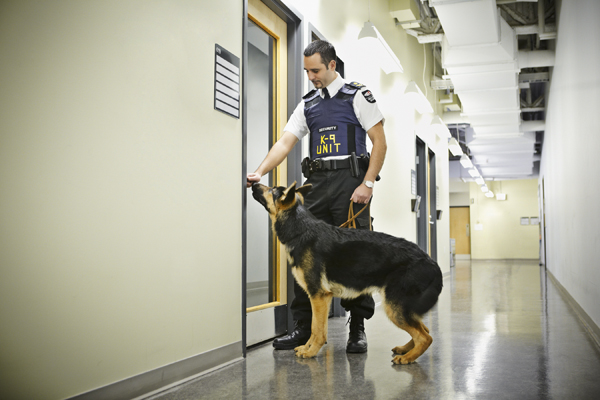
Program coordinator Keith Melo demonstrates the K-9 program at the School of Emergency Management at Casa Loma campus in this promotional photo. Photo: Matthew Plexman/Plexman Photography
How do you react in an emergency? Do you have a 72 hour plan for yourself and your family? A grab-and-go disaster preparedness kit? Where is your shelter? Do you know the number of services and communication lines to call? Do you know the techniques of conflict prevention and emotional de-escalation? Ask yourself, are you ready?
Always ready should be the motto of the George Brown School of Emergency Management where industry leaders and first responders conduct professional training for students.
“This real work experience they contribute to the class environment increases the value of the learning,” said Patricia Maclean, a student in the public health emergency management program (EM). “It creates personal comprehension of the importance the first responders’ work, such as paramedics, police and fire.”
It’s a professional environment with professors and most of the students providing first-hand experience. Book materials are supported by case studies which puts you in real life events where each student has a role, from a city mayor to a civilian.
An essential part of the program is team engagement and partnership. Program coordinator, Keith P. Melo said, “The field of emergency management is about collaboration and having a pool of brains that are there to support you during the disaster.”
This summer the school had a training for the college’s senior executives who were given worst scenarios that could ever happen at school, including the preparedness to an active shooter danger. After all training the management “realized how important it is to be prepared,” Melo said.
EM professor David Stephen Rowland said, “During my 38 years I have responded to a number of disasters including bus accidents, multiple car accidents, train derailment, airplane crashes, and have evacuated two hospitals, a nursing home and apartment buildings due to fires.”
This program offers students a chance to gain industry credentials which can be applied by working in the field, volunteering or in their personal life.
“I volunteer with many organizations for the satisfaction I get when I help those in need,” said EM student Shannon Toomey.
“I was sent to Thunder Bay to assist with the 2012 flooding, as well as the 2013 Kawartha Lakes one. It is within my role with the Canadian Red Cross that I am able to utilize my emergency management, whether that involves my knowledge in crisis communication, incident management or even the psychosocial response components,” said Toomey.
According to Richard Bochenek, who is a protocol development officer at Public Health Ontario and professor in the program, prevention, mitigation, preparedness, response and recovery elements should be always envisaged in the emergency management cycle.
“In any emergency no matter what kind of emergency it is, all of those faces occur and it’s cyclically containable. Every event displays those functions and we can take specific actions,” said Bochenek.
In addition to any plan, they recommend to have a back-up plan. As a former EM student, Francoise Caron said, “Hope for the best but plan for the worst.”
Clarification:
An earlier photo caption indicated that the K-9 team was a “law enforcement team working at Casa Loma campus”. The photo is a staged shot by the School of Emergency Management to demonstrate the K-9 program.

